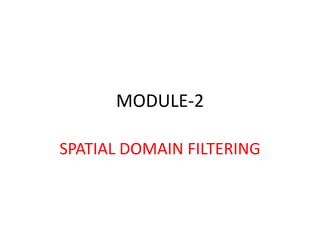The document provides an overview of spatial and frequency domain filtering techniques used in image enhancement. It discusses various methods, including intensity transformations, histogram processing, and filtering strategies, outlining their mathematical principles and applications. Additionally, it highlights key concepts such as contrast stretching, histogram equalization, and image arithmetic for achieving improved image quality.











![Linear Transformation
• It is also known as negative and identity
transformations.
• The negative of an image with gray levels[0 to
L-1] is obtained by negative transformation
which is shown in next figure,
• s=L-1-r](https://image.slidesharecdn.com/module-2-181023115131/85/Module-2-12-320.jpg)
















![Histogram Processing
• The Histogram of the digital Image having r gray levels in the
range[0 to L-1] is the discrete function h(rk)=nk. Where rk
represents the k th gray level and nk represents the number of
pixels in the image having gray level rk.
• Common practice is to normalize the histogram by dividing
each of its value by the total number of pixels in the image.
• Normalized Histogram is given by P(rk)=nk /n where k ranges
from 0 to L-1.
• P(rk) gives the probability of occurrence of gray level rk .](https://image.slidesharecdn.com/module-2-181023115131/85/Module-2-29-320.jpg)



![Histogram Equalization
• It’s a technique for adjusting image intensities to enhance the contrast of
images.
• Consider an image which is represented as mr X mc forms having gray
levels ‘r’ in the range 0 to L-1.
• In the initial part we discussed that r has been normalized to the range
[0 ,1]. Where 0 represents black and 1 represents white. And also we
considered a discrete function which allows pixels value to be in the
range[ 0 to L-1].
• For a value r , lets consider a transformation s=T(r) where 0<=r <=1
• Assume T(r) that it will satisfies the following conditions
1. T(r) is single valued and monotonically increasing in the range 0<=r <=1
2. 0<=T(r)<=1 for the r value 0<=r <=1.](https://image.slidesharecdn.com/module-2-181023115131/85/Module-2-33-320.jpg)


![• The grey levels in an image may be viewed as random
variables in the intervals [0, 1].
• PDF is one of the main descriptors of the random variables.
• Let pr(r) and ps(s) denotes PDF of two random variables r and
s.
• If pr(r) and T(r) are known, T-1 (s) satisfies the 1st condition
then ps(s) will be obtained by
ps(s)= pr(r)mod(dr/ds)……………..(1)
• A transformation function of particular importance has the
form s=T(r) = 0
𝑟
𝑡 𝑟(𝑤) ……..(1.1) where w is the dummy
variable of integration.](https://image.slidesharecdn.com/module-2-181023115131/85/Module-2-36-320.jpg)
![• The RHS of the previous equation is CDF ( Cumulative
Distribution Function) of r.
• Given Transformation Tr(r) , we find ps(s) by applying equation
1.
• We know from basic calculus that the derivative of definite
integral with respect to upper limit is simply integrand
evaluated at that limit.
𝑑𝑠
𝑑𝑟
=
𝑑𝑇(𝑟)
𝑑𝑟
=
𝑑[ 0
𝑟
𝑝 𝑟
(𝑤)]
𝑑𝑟
= pr(r)………2
• Substituting the dr/ds value in equation 1 we will get ps(s)=1](https://image.slidesharecdn.com/module-2-181023115131/85/Module-2-37-320.jpg)
![• Because ps(s) is the probability density function it follows that
it must be 0 outside the interval[0,1].
• In this case because its integral over all of its values is one,
ps(s) is Uniform probability distributed function.
• For discrete values we deal with probabilities and summation.
The probabilities of occurrence of grey level rk in an image is
given by pr(rk)=nk/n where k ranges from 0 to L-1.
• The discrete version of the transformation function 1.1 is
given by ……….(4)](https://image.slidesharecdn.com/module-2-181023115131/85/Module-2-38-320.jpg)










![Frequency Domain filtering
fundamentals
• Filtering in the frequency domain consists of modifying the
fourier transform of an image and then computing the inverse
transform to obtain the processed result.
• Thus the given digital image f(x,y) of size M X N the basic
filtering equation in which we are interested has the form
g(x,y)=[T^-1(H(u,v)F(u,v)]
• Where H(u,v) are filter functions F(u,v ) is DFT.
• g(x,y) is the filtered image.
• The product H(u,v)and F(u,v) are formed using array
multiplication.
• The function modifies the transform of the image to yield the
processed output.](https://image.slidesharecdn.com/module-2-181023115131/85/Module-2-49-320.jpg)




![• g(x,y)=[T^-1(H(u,v)F(u,v)] this equation involves the product
of two functions in frequency domain which by properties it is
the convolution in spatial domain.
• If the functions in the questions are not padded then we can
except wrap around error.
• So padding the image with the border causes the uniform
boundary around periodic sequence](https://image.slidesharecdn.com/module-2-181023115131/85/Module-2-54-320.jpg)
![Steps for filtering in the frequency
domain
1. Given an input image f(x,y) of size M X N, obtain the padding parameters
P and Q. typically we pad P=2M and Q=2N
2. Form the padding image, fp(x,y) of size P and Q by appending necessary
number of zeros
3. Multiply fp(x,y) by (-1)^(x+y) to center its transform.
4. Compute the DFT of the image from step 3.
5. Generate a real symmetric filter function, H(u,v) of size P X Q with center
at coordinates (P/2, Q/2).
6. Form the product G(u,v)=H(u,v)F(u,v) using array multiplication
7. Obtain the processed image. gp(x,y)= 𝑟𝑒𝑎𝑙[𝑇−1[𝐺 𝑢, 𝑣 ] −1 𝑥+𝑦
8. Obtain the final processed result g(x,y), by extracting the MXN region.](https://image.slidesharecdn.com/module-2-181023115131/85/Module-2-55-320.jpg)




![• D(u,v)=[ 𝑢 −
𝑃
2
2
+ 𝑣 −
𝑄
2
2
]^(1/2)](https://image.slidesharecdn.com/module-2-181023115131/85/Module-2-60-320.jpg)

![• If the DFT has been centered a circle of radius D0 with origin at the center
of the frequency rectangle encloses 𝛼 percent of power where
𝛼=100[ 𝑢 𝑣
𝑃 𝑢,𝑣
𝑃𝑇
]
• Summation is taken over the values of(u,v) that lie inside the circle or on
its boundary.](https://image.slidesharecdn.com/module-2-181023115131/85/Module-2-62-320.jpg)



























